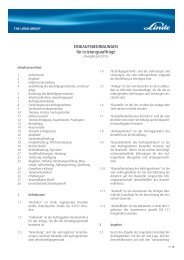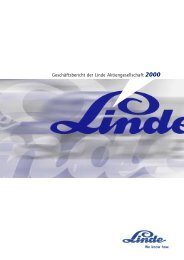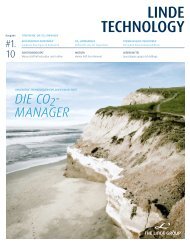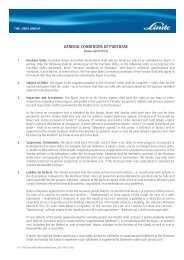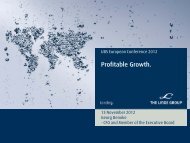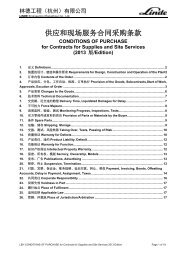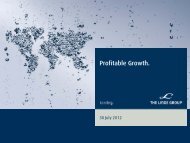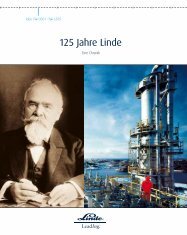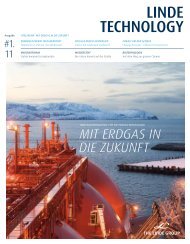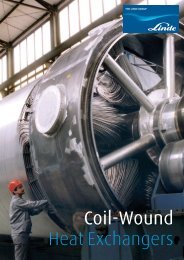Hydrogen Recovery by Pressure Swing Adsorption - Linde ...
Hydrogen Recovery by Pressure Swing Adsorption - Linde ...
Hydrogen Recovery by Pressure Swing Adsorption - Linde ...
- No tags were found...
You also want an ePaper? Increase the reach of your titles
YUMPU automatically turns print PDFs into web optimized ePapers that Google loves.
<strong>Hydrogen</strong> <strong>Recovery</strong><strong>by</strong> <strong>Pressure</strong><strong>Swing</strong> <strong>Adsorption</strong>
2Contents.3 Introduction4 The process5 The PSA sequence6 Scope of supply7 The advantages8 Contact
3Introduction.The experience.The use of the <strong>Pressure</strong> <strong>Swing</strong> <strong>Adsorption</strong> (PSA) processhas seen tremendous growth during the last decadesmainly due to its simplicity and low operating costs.Major applications have been the recovery of high purityhydrogen, methane and carbon dioxide as well as thegeneration of nitrogen and oxygen. In addition, it hasgained significance for the bulk removal of carbondioxide from direct reduction top-gases.<strong>Linde</strong> as the world leader in adsorption technologyhas designed and supplied more than 500 PSA plants– including the world‘s largest units and units withhighest availability.The <strong>Linde</strong> hydrogen PSA unitsThe well proven <strong>Linde</strong> High Performance <strong>Pressure</strong><strong>Swing</strong> <strong>Adsorption</strong> (PSA) units are designedfor the recovery and purification of pure hydrogenfrom different hydrogen - rich streams, suchas synthesis gases from steam reforming or gasificationprocesses, or from various off-gases inrefinery or petrochemical plants.Capacities range from a few hundred Nm³/h tolarge scale plants with more than 400,000 Nm³/h.The hydrogen product meets every purity requirementup to 99.9999 mol-% and is achieved athighest recovery rates.Main hydrogen consumers are refineries requiringthis valuable gas for example for their hydrocracking,dearomatization or desulphurizationprocesses.As a second group of users the petrochemicalindustry has a considerable demand for hydrogenfor its processes (e.g. methanol and ammoniasynthesis). Additionally, <strong>Linde</strong> provides PSAsolutions to a variety of other consumers like theelectronics, biomass, and steel industries.<strong>Linde</strong>‘s PSA systems have proven to be successfulin cases where performance, flexibility, availabilityand reliability are the determining factors.High quality and easy accessibility to all componentsminimize and facilitate maintenance to themaximum extent.
4The process.Separation <strong>by</strong> adsorptionThe <strong>Pressure</strong> <strong>Swing</strong> <strong>Adsorption</strong> (PSA) techno logyis based on a physical binding of gas moleculesto adsorbent material. The respective force actingbetween the gas molecules and the adsorbentmaterial depends on the gas component,type of adsorbent material, partial pressure ofthe gas component and operating temperature.A qualitative ranking of the adsorption forces isshown in the figure below.The separation effect is based on differences inbinding forces to the adsorbent material. Highlyvolatile components with low polarity, such ashydrogen, are practically non-adsorbable asopposed to molecules like N 2 , CO, CO 2 , hydrocarbonsand water vapour. Consequently, theseimpurities can be adsorbed from a hydrogencontainingstream and high purity hydrogen isrecovered.<strong>Adsorption</strong> and regenerationThe PSA process works at basically constanttemperature and uses the effect of alternatingpressure and partial pressure to perform adsorptionand desorption. Since heating or cooling isnot required, short cycles within the range ofminutes are achieved. The PSA process consequentlyallows the economical removal of largeamounts of impurities.The figure on page 5 illustrates the pressureswing adsorption process. It shows the adsorptionisotherms describing the relation betweenpartial pressure of a component and its equilibriumloading on the adsorbent material for agiven temperature.<strong>Adsorption</strong> is carried out at high pressure (andhence high respective partial pressure) typicallyin the range of 10 to 40 bar until the equilibriumloading is reached. At this point in time, nofurther adsorption capacity is available and theadsorbent material must be regenerated. Thisregeneration is done <strong>by</strong> lowering the pressureto slightly above atmospheric pressure resultingin a respective decrease in equilibrium loading.As a result, the impurities on the adsorbentmaterial are desorbed and the adsorbent materialis regenerated. The amount of impurities removedfrom a gas stream within one cyclecorresponds to the difference of adsorption todesorption loading.After termination of regeneration, pressure isincreased back to adsorption pressure level andthe process starts again from the beginning.Qualitative ranking of adsorption forces<strong>Pressure</strong> swing adsorption plant in Leuna, Germany<strong>Hydrogen</strong>weakOxygenArgonNitrogenCarbon monoxideMethaneCarbon dioxideEthaneEthylenePropaneButanePropyleneAmmonia<strong>Hydrogen</strong> sulfideMercaptanesBTXWaterstrong
5<strong>Adsorption</strong> isotherms<strong>Adsorption</strong> loading0°CDifferential loading30°C50°CDesorption loading200°CP DDesorption pressurePartial pressureP A<strong>Adsorption</strong> pressureThe PSA sequence.<strong>Adsorption</strong> and regeneration <strong>by</strong> pressure swingA PSA plant consists basically of the adsorbervessels containing the adsorbent material, tailgas drum(s), valve skid(s) with interconnectingpiping, control valves and instrumentation aswell as a control system for control of the unit.The pressure swing adsorption process has fourbasic process steps:– <strong>Adsorption</strong>– Depressurization– Regeneration– RepressurizationTo provide continuous hydrogen supply, minimum4 adsorber vessels are required. The figureon page 6 shows the combination of the sequencesof four adsorber vessels as a pressure-timediagram.<strong>Adsorption</strong><strong>Adsorption</strong> of impurities is carried out at highpressure being determined <strong>by</strong> the pressure ofthe feed gas. The feed gas flows through theadsorber vessels in an upward direction. Impuritiessuch as water, heavy hydrocarbons, lighthydrocarbons, CO 2 , CO and nitrogen are selectivelyadsorbed on the surface of the adsorbentmaterial. Highly pure hydrogen exits the adsorbervessel at the top. After a defined time, theadsorption phase of this vessel stops and regenerationstarts. Another adsorber takes over thetask of adsorption to ensure continuous hydrogensupply.RegenerationThe regeneration phase consists of basicallyfive consecutive steps:– <strong>Pressure</strong> equalization– Provide purge– Dump– Purging– RepressurizationThe steps are combined so as to minimize hydrogenlosses and consequently to maximize thehydrogen recovery rate of the PSA system.<strong>Pressure</strong> equalization (step E1)Depressurization starts in the co-current directionfrom bottom to top. The hydrogen still storedin the void space of the adsorbent material isused to pressurize another adsorber having justterminated its regeneration. Depending on thetotal number of adsorbers and the process conditions,one to four of these so-called pressureequalization steps are performed. Each additionalpressure equalization step minimizeshydrogen losses and increases the hydrogenrecovery rate.Provide purge (step PP)This is the final depressurization step in cocurrentdirection providing pure hydrogen topurge or regenerate another adsorber.Dump (step D)At a certain point of time, the remaining pressuremust be released in counter-current directionto prevent break-through of impurities atthe top of the adsorber. This is the first step ofthe regeneration phase when desorbed impuritiesleave the adsorber at the bottom and flowto the tail gas system of the PSA plant.
6Scope of supply.Purging (regeneration)Final desorption and regeneration is performedat the lowest pressure of the PSA sequence.Highly pure hydrogen obtained from an adsorberin the provide purge step, is used to purge thedesorbed impurities into the tail gas system.The residual loading on the adsorbent material isreduced to a minimum to achieve high efficiencyof the PSA cycle.Repressurization (steps R1/R0)Before restarting adsorption, the regeneratedadsorber must be pressurized again. This isaccomplished in the pressure equalization step<strong>by</strong> using pure hydrogen from adsorbers presentlyunder depressurization. Since final adsorptionpressure cannot be reached with pressureequalization steps, repressurization to adsorptionpressure is carried out with a split streamfrom the hydrogen product line.Having reached the required pressure levelagain, this regenerated adsorber takes over thetask of adsorption from another vessel havingjust terminated its adsorption phase.The typical scope of supply of <strong>Linde</strong>‘s PSAunits includes:– Prefabricated valve skid– Adsorber vessels– Specially selected adsorbent material– Tail gas drum– Process control systemThe scope can be altered to best suit client‘sneeds. Based on the customer‘s requirements,feed gas compressor or tail gas compressorsystems can be offered through <strong>Linde</strong> as anintegrated PSA solution.PSA valve skid<strong>Pressure</strong> time diagram<strong>Pressure</strong>Adsorber A<strong>Adsorption</strong>E1R0PPDRegenerationR1Adsorber BR0<strong>Adsorption</strong>E1R1PPDRegenerationAdsorber CR0<strong>Adsorption</strong>E1DAdsorber DRegenerationR1PPR0<strong>Adsorption</strong>E1PPDRegenerationR1Time
7The advantages.Two pressure swing adsorption units in CanadaThe <strong>Linde</strong> High Performance PSA units provideremarkable advantages such as:<strong>Linde</strong>‘s 30 years of expertise in adsorptiontechnologyBased on specific customer requirements, <strong>Linde</strong>specialists select the optimal PSA system for distinctpurification tasks in order to achieve a perfectbalance between plant performance andinvestment costs.Quality and reliabilityPSA process requirements make an informedselection of specially proven plant components(e.g. switching valves and related instrumentation)necessary. <strong>Linde</strong> only uses suitable andthoroughly selected, tested and approved plantcomponents. This guarantees highest reliabilityof <strong>Linde</strong>’s PSA systems.Outstanding availability<strong>Linde</strong> PSA systems are characterized <strong>by</strong> an outstandingavailability of hydrogen supply. With itsspecial features such as operation with reducednumber of adsorbers, adsorber group isolationand redundant control system, <strong>Linde</strong> PSA systemsachieve virtually 100% on-stream performanceand availability.Excellent flexibility<strong>Linde</strong> PSA systems achieve excellent flexibilityin coping with varying feed gas conditions andhydrogen demands to match individual clientneeds.Modular design and prefabricated equipment<strong>Linde</strong> High Performance PSA systems are prefabricatedto the maximum extent. The valve skidcontaining switching and control valves, instrumentationand interconnecting piping is completelyprefabricated, preassembled and testedprior to delivery. This design philosophy reducestime and costs for erection and commissioningon site to the absolute minimum.Easy maintenanceMaintenance necessity is limited to routine actions,which can be carried out <strong>by</strong> the operatorson site. <strong>Linde</strong> pays highest attention to properaccessibility of all valves and instruments insidethe valve skid. Hence, maintenance assistancefrom <strong>Linde</strong> is normally not required, but is certainlyavailable at any time.
Designing processes – constructing plants.<strong>Linde</strong>´s Engineering Division continuously develops extensive process engineering know-how in the planning,project management and construction of turnkey industrial plants.The range of products comprises:− Petrochemical plants− LNG and natural gas processing plants− Synthesis gas plants− <strong>Hydrogen</strong> plants− Gas processing plants− <strong>Adsorption</strong> plants− Air separation plants− Cryogenic plants− Biotechnology plants− Furnaces for petrochemical plants and refineriesThe Engineering Divisionand its subsidiaries manufacture:− Packaged units, cold boxes− Coil-wound heat exchangers− Plate-fin heat exchangers− Cryogenic standard tanks− Air heated vaporizers− Spiral-welded aluminium pipesMore than 4,000 plants worldwide document the leading position of the Engineering Division in internationalplant construction.Engineering DivisionSchalchen PlantTacherting, GermanyPhone +49.8621.85-0Fax +49.8621.85-6620plantcomponents@linde-le.com<strong>Linde</strong> Engineering Dresden GmbHDresden, GermanyPhone +49.351.250-30Fax +49.351.250-4800ledd.dresden@linde-le.comSELAS-LINDE GmbHPullach, GermanyPhone +49.89.7447-470Fax +49.89.7447-4717selas-linde@linde-le.comCryostar SASHésingue, FrancePhone +33.389.70-2727Fax +33.389.70-2777info@cryostar.com<strong>Linde</strong> CryoPlants Ltd.Aldershot, Great BritainPhone +44.1.252.3313-51Fax +44.1.252.3430-62info@linde-lcl.com<strong>Linde</strong> Impianti Italia S.p.A.Rome, ItalyPhone +39.066.5613-1Fax +39.066.5613-200m.margheri@lindeimpianti.it<strong>Linde</strong> Kryotechnik AGPfungen, SwitzerlandPhone +41.52.3040-555Fax +41.52.3040-550info@linde-kryotechnik.chBertrams Heatec AGPratteln, SwitzerlandPhone +41.61.467-7525Fax +41.61.467-7500hubertus.winkler@linde-le.comCRYO ABGothenburg, SwedenPhone +46.3164-6800Fax +46.3164-2220lars.persson@cryo.aga.com<strong>Linde</strong> Process Plants, Inc.Tulsa, OK, U.S.A.Phone +1.918.4771-200Fax +1.918.4771-100sales@lppusa.comSelas Fluid Processing Corp.Blue Bell, PA, U.S.A.Phone +1.610.834-0300Fax +1.610.834-0473sales@selasfluid.com<strong>Linde</strong> Engenharia do Brasil Ltda.São Paulo, BrazilPhone +55.21.3545-2255Fax +55.21.3545-2257jaime.basurto@linde.com<strong>Linde</strong> Process Plants (Pty.) Ltd.Johannesburg, South AfricaPhone +27.11.490-0513Fax +27.11.490-0412linde.za@linde-le.com<strong>Linde</strong> Engineering Dresden GmbHMoscow Office, RussiaPhone +7.495.6426-242ledd.moscow@linde-le.com<strong>Linde</strong> Arabian Contracting Co. Ltd.Riyadh, Kingdom of Saudi ArabiaPhone +966.1.419-1193Fax +966.1.419-1384jochen.nippel@linde-le.com<strong>Linde</strong> Arabian Contracting Co. Ltd.Al-Khobar, Kingdom of Saudi ArabiaPhone +966.3.887-1191Fax +966.3.887-0133klaus.libal@linde-le.com<strong>Linde</strong> Engineering Middle East LLCAbu Dhabi, United Arab EmiratesPhone +971.2.6981-400Fax +971.2.6981-499leme@linde.com<strong>Linde</strong> Engineering India Pvt. Ltd.Vadodara, Gujarat, IndiaPhone +91.265.3056-789Fax +91.265.2461-757sales@linde-le.com<strong>Linde</strong> Engineering Far East, Ltd.Seoul, South KoreaPhone +82.2789-6697Fax +82.2789-6698hanyong.lee@linde.com<strong>Linde</strong> Engineering DivisionBangkok, ThailandPhone +66.2751-9200Fax +66.2751-9201anuwat.krongkrachang@linde.com<strong>Linde</strong> Engineering Co. Ltd.Dalian, P.R. of ChinaPhone +86.411.3953-8819Fax +86.411.3953-8899info@lindeLED.com<strong>Linde</strong> Engineering Co. Ltd.Hangzhou, P.R. of ChinaPhone +86.571.8501-9222Fax +86.571.8501-9200info@lindeLEH.com<strong>Linde</strong> Engineering DivisionBeijing Representative OfficeBeijing, P.R. of ChinaPhone +86.10.6437-7014Fax +86.10.6437-6718info@linde-lecn.com<strong>Linde</strong> Engineering Taiwan Ltd.Taipei, TaiwanPhone +886.2.2786-3131Fax +886.2.2652-5871tso.ming.hsieh@linde-le.com<strong>Linde</strong> AGEngineering Division, Head office, Dr.-Carl-von-<strong>Linde</strong>-Strasse 6-14, 82049 Pullach, GermanyPhone +49.89.7445-0, Fax +49.89.7445-4908, E-Mail: info@linde-le.com, www.linde-engineering.comHA/H/1.1.e/12



